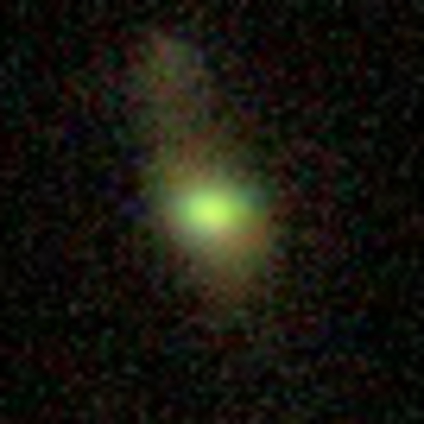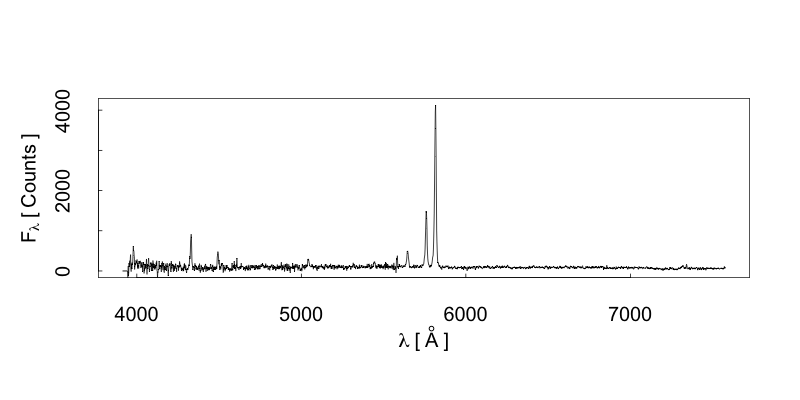Neon green nucleus
-
 by
zutopian
by
zutopian
No spectrum in SDSS and no info in NED. #Green nucleus looks weird.
Misalignment?
#AGN ?
Reminds me of a #greenpea , but it looks like a spiral.Posted
-
weird barred ring 4 me
Posted
-
 by
zutopian
by
zutopian
How does it look on the FITS images? I have however no available link to view those.
Posted
-
in the midst of this (Very) active discussion, I can confirm that the green line in the galaxy is not an artifact.
Posted
-
 by
Budgieye
moderator
by
Budgieye
moderator
I think we might contact a scientist about this one. Anyone have any ideas on what it may be? Is C. Cardamone a good person to contact?
posted in the Forum
http://www.galaxyzooforum.org/index.php?topic=280493.msg620397#msg620397 by Zutopian
http://www.galaxyzooforum.org/index.php?topic=3515.msg626165#msg626165 by Tony Wei
Posted
-
 by
ccardamone
scientist
by
ccardamone
scientist
Hi, The deep green color does suggest an emission line dominating the "R" filter. This is just what happens with the Peas. However, it can also happen with AGN. There are a set of Narrow Line Seyfert I galaxies (a type of AGN) that appeared in the original Peas sample. Given the morphology of this galaxy, my best guess is that this is one of those galaxies. That means the color would be caused by accretion around a black hole and not star formation. Without a spectrum however, there is no way to know for sure.
- Carie
Posted
-
 by
Budgieye
moderator
by
Budgieye
moderator
Thank you ccardamone. Maybe we should start a hopeful Hubble list for unusual objects that need a closer look.
Posted
-
 by
Alpha_Aurigae
in response to Budgieye's comment.
by
Alpha_Aurigae
in response to Budgieye's comment.
I second that 😃
Posted
-
This one has a green nucleus too, and it is a Markarian galaxy: AGZ00020j8 .
And this galaxy is an AGN: AGZ0004e9dPosted
-
 by
Budgieye
moderator
by
Budgieye
moderator
Nice examples, thank you Alpha Auriga. The first has a spectrum. There is oxygen and hydrogen, so it is a pea #pea and an AGN #agn There may be a double nucleus, interacting, and with eventual fusion, with big boom and gravity waves.

http://www.galaxyzoo.org.s3.amazonaws.com/subjects/standard/1237657067403542567.jpg
http://talk.galaxyzoo.org/#/subjects/AGZ00020j8
MRK 0563 #MRK

OIII peaks in the middle(green) and hydrogen alpha over to the right.
http://ned.ipac.caltech.edu/spc1/2009/2009MNRAS.399..683J/121/6dFJ0111500-013918:S:VR:j2009_sp.png
SDSS J011149.97-013918.4
http://skyserver.sdss3.org/dr8/en/tools/explore/obj.asp?id=1237657067403542567
Publication: http://iopscience.iop.org/0004-637X/675/2/1459/pdf/72322.web.pdf
Posted
-
 by
Budgieye
moderator
by
Budgieye
moderator
The second one: NED says a flat spectrum radio #radio source.Optical spectrum below. looks like hydrogen alpha only, so an active nucleus only AGN #AGN with a hint of star-forming.

http://www.galaxyzoo.org.s3.amazonaws.com/subjects/standard/1237676672850722955.jpg
SDSS J015006.21-164033.2
http://skyserver.sdss3.org/dr8/en/tools/explore/obj.asp?id=1237676672850722955

http://ned.ipac.caltech.edu/spc1/2009/2009MNRAS.399..683J/11/6dFJ0150062-164033:S:VR:j2009_sp.png
looks like hydrogen alpha only, so an AGN #AGN.
NED says a flat spectrum radio #radio source.
http://skyserver.sdss3.org/dr8/en/tools/explore/obj.asp?id=1237676672850722955
posted by zutopian http://www.galaxyzooforum.org/index.php?topic=280592.msg624157#msg624157
http://cas.sdss.org/dr7/en/tools/explore/obj.asp?id=587748061117022274 nothing in forum under 58...
Posted
-
 by
Dolorous_Edd
by
Dolorous_Edd
I wonder could this be a giant radio galaxy? Host SDSS J015006.21-164033.2
Image from NVSS survey ( also visible in VLSSr )

For photo_z = 0.3 and ~4' size this would be around 1,1 Mpc
Edit NED gives redshift = 0.161551 the size will be around 600 - 700 kpc*
Here is SDSS image with contours from NVSS

Posted
-
 by
Budgieye
moderator
by
Budgieye
moderator
Wow that is huge. Thank you Dolorous Edd.
I tried to do a search there using SDSS J015006.21-164033.2 but I got zero results.
Can you make a link to the Talk page?
Posted
-
 by
Dolorous_Edd
in response to Budgieye's comment.
by
Dolorous_Edd
in response to Budgieye's comment.
Done
Posted
-
 by
Budgieye
moderator
by
Budgieye
moderator
Sorry, I meant can you post a hot link here, that will take me to something in Radio Galaxy Zoo?
Posted
-
 by
Dolorous_Edd
in response to Budgieye's comment.
by
Dolorous_Edd
in response to Budgieye's comment.
How about this thread?
http://radiotalk.galaxyzoo.org/#/boards/BRG0000003/discussions/DRG00001mg
Posted
-
 by
Budgieye
moderator
by
Budgieye
moderator
Thank you again, there it is on page 5. I really should get into radio galaxies.
What does flat spectrum mean in radio? In optical, it usually means a blazar, looking at a quasar face-on.
What is a triple? a source and 2 jets?
Posted
-
Wow, you two have been busy 😃. A lot of this is new for me, so I have to read your analyses a number of times before I can even begin to understand all the information. It is very educational, and even more appreciated. Thanks 😃.
Posted
-
 by
JeanTate
in response to Budgieye's comment.
by
JeanTate
in response to Budgieye's comment.
NED gives its redshift as 1.161551, presumably from the 6dF survey. At this redshift, Hα would be beyond the red end of the spectrum posted; the three prominent emission lines between 5k and 6k Å are Hβ and the two [OIII] nebular lines (rest, vacuum, wavelengths 5008Å and 4960Å); the other prominent one - between 4k and 5k Å - is the [OII] doublet (ditto, ~3727Å).
There's too little info in the spectrum to say*, with any certainty, simply by visual inspection, whether the emission lines are more likely due to an AGN, or a star-formation region (possibly a star-burst), or both. A quantitative analysis might give a fairly robust answer.
*IMO; if an astronomer with particular expertise in this field were to drop by, would you please comment?
Posted
-
 by
JeanTate
in response to Budgieye's comment.
by
JeanTate
in response to Budgieye's comment.
What is a triple? a source and 2 jets?
Yes; or more usually, a host (core, an AGN) and two lobes (more or less where the jets terminate in the inter-galactic medium).
Posted
-
 by
Budgieye
moderator
by
Budgieye
moderator
If I have the SDSS number, how do I find the corresponding image in Radio Galaxy Zoo Talk? I went into Search, and I tried putting all the variations of the SDSS number that I could think of. I tried replacing SDSS with FIRST but it didn't help, maybe I didn't do it correctly.
Posted
-
 by
Budgieye
moderator
in response to JeanTate's comment.
by
Budgieye
moderator
in response to JeanTate's comment.
So that galaxy with the green nucleus that we see is not related to the huge lobed radio source in the sky?
But there's nothing there 😦
http://talk.galaxyzoo.org/#/subjects/AGZ0004e9d
Open in Tools
..err ..how do I get to the infrared data?
oh, ... open in Examine and look at the z band.
http://www.galaxyzoo.org/#/examine/AGZ0004e9d
the source would be just outside the image, but still I don't see anything there.
Posted
-
 by
Dolorous_Edd
in response to Budgieye's comment.
by
Dolorous_Edd
in response to Budgieye's comment.
If I have the SDSS number, how do I find the corresponding image in Radio Galaxy Zoo Talk? I went into Search, and I tried putting all the variations of the SDSS number that I could think of. I tried replacing SDSS with FIRST but it didn't help, maybe I didn't do it correctly.
You will find it only if somebody put SDSS number in commentary. It is still possible to find related RGZ picture if you have coordinates, but you have to ask Jean Tate for this
From personal experience :
When search by SDSS ID don't put SDSS prefix ( it will give too many results )Example: if you want to search for SDSS J015006.21-164033.2
Search for J015006.21-164033.2
So that galaxy with the green nucleus that we see is not related to the huge lobed radio source in the sky?
I think that SDSS J015006.21-164033.2 is the source of radio emission
Although for z = 0.161551 the size will be around 672kpc
Sadly, outside VLA FIRST survey that would have made things clearer
how do I get to the infrared data
Posted
-
I'd like to throw another galaxy into the mix, this one also has a green nucleus: AGZ00030he
Posted
-
 by
Budgieye
moderator
by
Budgieye
moderator
wow another brilliant green nucleus, no publications, nothing in NED. no spectrum, tried search in Radio Galaxy Zoo, didn't find anything, my search technique may be unsatisfactory.
SDSS J022624.58+054242.2
Maybe "pea" type galaxies don't have relativisitic jets.
z 0.146622
zErr 0.062622Posted
-
 by
vrooje
admin, scientist
in response to Alpha Aurigae's comment.
by
vrooje
admin, scientist
in response to Alpha Aurigae's comment.
While this is certainly not true of every object in this thread, I think the green in AGZ00030he is an artifact based on looking at the rest of the sources around it. 😦
Posted
-
 by
JeanTate
in response to Dolorous Edd's comment.
by
JeanTate
in response to Dolorous Edd's comment.
Concerning finding RGZ objects ...
If I have the SDSS number, how do I find the corresponding image in Radio Galaxy Zoo Talk? I went into Search, and I tried putting all the variations of the SDSS number that I could think of. I tried replacing SDSS with FIRST but it didn't help, maybe I didn't do it correctly.
You will find it only if somebody put SDSS number in commentary. It is still possible to find related RGZ picture if you have coordinates, but you have to ask Jean Tate for this
You may find this RGZ Talk thread of interest: Given coordinates, or a FIRST ID, how to find the ARG ID(s), if there is one? (there's also a similar GZT one too*). To quote from the last post:
My Plan B worked sufficiently well for the purpose I intended. And it's likely a method that could be pretty easily generalized so that if a particular FIRST source is among the ARG IDs, then it could be found within seconds (perhaps not with 100% reliability though).
My coding skills are poor indeed, yet given that my Plan B works about as well as I had expected, surely it's not a stretch to think a member of the Development Team (or any one of hundreds of other ordinary zooites) could code up a half-way decent tool, to find ARG IDs given coordinates (if such ARG IDs exist)? True, the reliability may be only ~90%. What's more, as coding newbie me took mere ~hours, a skilled person could do the job in ~an hour, wouldn't you think?
*I expect doing something similar for GZ, even if to find only an AGZ ID among SDSS objects, would be more challenging.
Posted
-
 by
Budgieye
moderator
by
Budgieye
moderator
Thank you vrooje, you are correct, many objects are green in that image.
Posted
-
Thanks for looking into AGZ00030he . I wish I had consulted the Skyserver image first, but my enthusiasm got in the way. Not the first time.
P.S. I have been having laptop problems but I will be back later this week.
Cheers,
AbePosted